The School of Rock
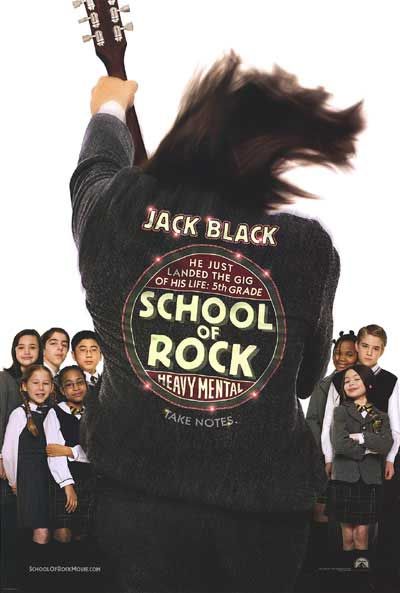 The School of Rock The School of Rock is many things. It’s an unapologetic crowd pleaser. It’s probably the vehicle that will cement Jack Black’s comic stardom. It’s the newest Richard Linklater film (and don’t be put off by the film’s commercial context, the film is solidly a Linklater film, announcing itself as such from the opening shot: a long, roving take with the camera snaking along the back corridors of a rundown nightclub, swaying back and forth, capturing the film’s opening credits, which take the form of various rock club paraphernalia, i.e. the back of a leather jacket, posters, graffiti, and a red neon sign emblazoned with the film’s title). It’s an example of the teaching sub-genre, where a non-comformist teacher shakes up the establishment, though, any comparisons to dreck like Dead Poets Society are certainly misplaced. It’s another example of the resurgence of the musical (it’s another variation on the “let’s put on a show” sub-genre of the musical; in many ways the film reminded me of another musical favorite from this year, Camp, where kids who are decidedly “different” or “uncool” find themselves by embracing a somewhat out of vogue musical genre). But more importantly, The School of Rock rocks!
Jack Black stars in the comedy (written by Mike White, who also co-stars in the film as Black’s roommate and best friend) as Dewey Finn, a slacker with dreams of becoming a guitar-rock god (though he’s at the age where most people would give up such dreams, like his roommate, Ned, a former cross-dressing, Satanic rocker, who’s become a substitute teacher with an emasculating harpy of a girlfriend). Dewey may be a somewhat mediocre rocker but he possesses a few traits that could pave the way to his success: a shrewd sense of talent, a manic intensity, an unabashed confidence in himself, and an encyclopedic knowledge of Rock N’ Roll. Oh yeah, he’s also a consummate bullshit artist (in short, he’s the perfect teacher). After being fired from his rockband because of his on-stage antics (20 minute guitar solos, diving into the nearly empty, apathetic crowd), a despairing Dewey, in desperate need of rent money, impersonates his roommate and gets a job substitute teaching at a prestigious private school.
Dressed as a parody of a prep school teacher (complete with tweed jacket, bow tie, and scarf), his plans are to coast through the job for the $650 dollars a week, allowing the kids to have “recess,” but all that changes once Dewey learns that his class contains a whole bunch of musical prodigies (it’s actually my understanding, that many of the child actors who appear in the film are actual musical prodigies, who play and sing all their own parts). With a devilish grin, Dewey races to his rusting, smoke belching touring van to retrieve a Flying-V guitar and an electric bass. When the kids return to the class, Dewey tells them about “a secret class project,” to form a rock band to compete against other schools. The real plan is for Dewey to achieve rock stardom on the back of the kids, and to avenge the slight of being fired by his previous band, by winning the WROK Battle of the Bands.
Before you know it, Dewey, in the guise of Mr. S, has won the kids (the rapport between Black and the young actors is one of the film’s best traits) over with infectious enthusiasm and anarchic spirit of sticking it to The Man, opening up their buttoned down existence to new possibilities. The former geeky Asian kid afraid of being uncool becomes a whiz at the keyboards; an overweight young girl with an amazing singing voice gains self-confidence when Dewey talks about how Aretha Franklin blows everyone away when she performs; a young boy, formerly a blank slate, becomes the bands drummer and embraces the punk ethos; while the quiet, gawky geeky kid with an overbearing dad learns to loosen up and become the guitar god that Dewey always wanted to be. All the kids get in on the act, as Dewey parcels out jobs and responsibilities to the rest of the class: some of the bigger kids becomes the band security (actually tasked with making sure that the Principal, who I will say more about, doesn’t find out what is going on), while others become roadies. The class computer whiz is placed in charge of the lights and stage show, while the swishy, catty kid is put in charge of the band style (his first attempt at a band costume, is decidedly glam influenced); some of the girls become back-up singers, while others, with no discernible musical talent becomes “groupies” (or as Dewey describes the term, they are like “cheerleaders” for the band, their job being to think of the band’s name, as well as make tshirts and stuff). Even the teacher’s pet, the prim and proper class kissass, Summer, gets a job as the Band Manager, a job to which she takes to immediately.
Dewey’s presence in the school is a blast of fresh air, and even the rest of the faculty takes to him, including the initially suspicious principal, played by Joan Cusack 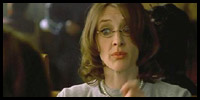 . Cusack, as usual, almost steals the movie out from under Black, doing what she does best, making a huge impression in a well-written supporting role. In this case she just takes off with it. Initially, Cusack’s Principal Ros comes off like an stern, button-downed matron, dressing in restrictive gray suits, and unable to connect with her students (in one early scene, she’s disciplining and then comforting a young student, but you can not really tell the difference), but as the movie progresses, we learn of her secret passion for Stevie Nicks, and that she hates what she has become due to the pressure of her job. Cusack is simply amazing, just to point out a few sequences: how her love of music slips out at the bar she visits with Dewey, as she mouths the words to the Nicks song; then afterwards, a bit tipsy, confides to Dewey how she really feels, confessing that she is not happy with her life, and that Dewey is the first teacher to ask her to do something outside of school in six years. Eventually, when Dewey is found out, there’s a quiet scene that would be cut out of most movies; after momentarily slipping out of her office filled with angry parents, looking like she’s about to have a panic attack, Cusack walks down a flight of stairs, and then simply turns around and slumps forward into the corner, completely deflated. It’s a testament to Mike White, who wrote the scene, Linklater, who allows the camera some distance to observe the moment, and Cusack who plays her character (one that could easily have transformed into a caricature in lesser hands) just right. I liked Cusack’s character so much, that I was glad that her character was rewarded when a young, guitar playing stud took an interest in her backstage, much to her flustered amazement (also her palpable sense of pride, when she walks back stage to confront Dewey, and tells the stage manager that she is “the band’s principal.”)
The ending is somewhat predictable but very enjoyable, just like the entire movie itself (and it should be noted that it’s hard to make a real crowd-pleaser that doesn’t leave you feeling “dirty” afterwards; hey, and this film even had a musical montage which was more than palatable, showing the class learning and practicing). Dewey is turned in by his roommate’s bitchy girlfriend, who is busted in front of his students angry parents (who were already mad at him for the changes in their kids responsibility, and his assignments to listen to rock music CDs). Forced the flee the scene after inadvertedly making the situation worse by telling the assembled parents that “I’ve been touched by your kids, and I’m pretty sure I’ve touched them,” (yes, this is a movie where an irresponsible adult learns, well responsibility, but I didn’t mind), Dewey pretty much gives up hope.
That is, until his former students take it upon themselves to sneak out of school, fetch Dewey at his apartment, and compete in the Battle of the Bands, as their band, The School of Rock. White’s character, Ned (who the night before, told Dewey he still misses the music), looking out the window, sees the excitement of the students as Dewey runs up to the “highjacked” school bus, and develops a backbone, dumping his girlfriend, and going to the concert himself to enjoy the music. On the other hand, the parents and Principal Roz, now completely freaked out that some sort of lunatic has kidnapped their kids, are in hot pursuit, and manage to get to the auditorium with minutes to spare, pushing their way to the front of the theater, just in time for their kids’ set to begin.
Backstage, Dewey calls for the band to play the song written by the gawky guitar player Zach (Dewey has an epiphany, and tells the students that the band is “ours”), who, as Dewey points out, when Zach begins to protest, is already a better player at 10 then Dewey will ever be, and that it is only appropriate for the band to play his song. The band then proceeds to blow the roof off the joint, to the amazement of the assembled parents, whose anger fades away, replaced with pride and amazement. Echoing the film’s first performance, where Dewey launched himself into the crowd, only to fall onto his face, he again throws himself into the crowd for some triumphant body surfing. In a nice twist, The School of Rock loses the Battle of the Bands to Dewey’s old band mates, which causes Dewey to collapse on a couch dejected; his students remind him “it’s not about winning, it’s about rocking!” and “it’s about putting on an amazing show.” Reanimated by his students absorption of his primary lesson, Dewey hears the protesting audience chant “School of Rock” and thinks that the audience is demanding an encore. The entire class, led by Dewey, rushes onto the stage, to the raucous applause of the audience, and begins to rock the house.
In the film’s coda, played under the film’s credits, we learn that Summer is managing the band, barking into a cellphone about the band being “lowballed” by promoters (it’s a nice, comic incongruity, so see this slight little girl get out of her mother’s station wagon, and tell someone off; it’s funny, how earlier, Summer’s mother complains that her daughter has become obsessed with David Geffen), and that Dewey and Ned have started their own “School of Rock.” As Dewey said before, those who can not do, teach. We see the two of them teach their respective classes, in another nice musical moment. The School of Rock and Camp are, in my mind, the one-two punch that has blown Chicago and Moulin Rouge! out of the water; principally, because their is a certain passion missing from the later films. I guess when it comes to musicals, I prefer real, rough around the edges enthusiasm to slick middlebrow fodder.
Question of the Week
The other day I was talking to a friend about a movie, and he used the word "odd" to describe it. Now, that got me thinking. Oddness is an interesting quality, so before we start the next "Unofficial Milk Plus Canon: 1995-1999" poll (start thinking about it now, but don't mention your choices in this thread), I'd like to pose this new question of the week, an ode to oddness:
Name a movie that you love, but which you would characterize as "odd." What is it about that movie that you find "odd" and does that "oddness" enhance your enjoyment of the film? Also, name a movie that you hate, but which you would also characterize as "odd." What is it about the movie that you find "odd" and does the that "oddness" detract from your enjoyment of the film?
Once a film has been mentioned, it can not be used again. Feel free to answer the question of the week in any order you like. Remember, the question of the week is open to all blog members and readers, so answer the question, and share the oddness with others (and take the challenge of the oddness, if you dare!)
More Short, Short Takes
Well, I saw a couple of other movies recently. So here are some short reviews of each of those films:
The Rundown (d. Peter Berg)
Because of the trailer, I was pretty jazzed about this movie. I find Seann William Scott to be hilarious, and hey, Christopher Walken himself graced the movie with his presence. Add to that Rosario Dawson, and let’s not forget, The Rock, who I have nothing against. Not only do I find him to be a credible action star, but I feel he also has an easy going charisma, which translates into an “everyday kind of guy” vibe, despite his hulking physique; plus, from what I’ve seen, he’s got something of a knack for comedy. Unfortunately, the end results of The Rundown really only adds up to a DVD rental or a ticket at the budget theater; it’s amusing and diverting, but nothing more. Dawson is pretty much wasted in her role as the noble guerilla leader, but more disappointing is Walken, who’s performance I found less than inspiring. Basically, no matter how amusing, I think he coasted through the role, trading in on his stock mannerisms, and doing nothing more. However, Seann William Scott and The Rock develop an quick rapport, forming a credible buddy team for this action-comedy. The Rock is more adept at presenting himself as a reluctant tough-guy, more interested in cooking and being a restauranteur, than Scott is as a Stanford dropout (smart ass rogue, yes), but you get a clear sense of character in each case. The story is pretty fairly generic (it seems to rip off the Indiana Jones movies as much as possible), but the action scenes vary in quality, some were crisp and exiting, others were muddled, digitally-enhanced blurs. I wouldn’t exactly queue up to see the next Peter Berg action opus, but The Rock has the potential to go places. Next time I want to see him work with a more talented director.
The 36th Chamber of Shaolin and Return to the 36th Chamber of Shaolin (d. Lau Kar-leung)
Neither film is up to the dizzying heights of The Intimate Confession of a Chinese Courtesan, but both of these films were very satisfying, though for quite different reasons. The 26th Chamber of the Shaolin is a fairly simple story, Gordon Liu (soon to be seen in Quentin Tarantino’s Kill Bill) plays a Han college student, whose nationalism leads him to join the resistance against the Manchus of the Ching dynasty. After the rebels are found out, and his family killed, Liu travels to the fabled Shaolin monastery, in an effort to learn kung fu and avenge his family, friends, and country. Folllowing seven years of study in the monastery’s 35 training chambers, Liu, rechristened San Te, is one of Shaolin’s most powerful kung fu warriors. Despite the Buddhist teachings I’d assume that San Te would have also received in the monastery, he is still driven by revenge, and wishes to institute a 36th chamber, to train Han laymen in kung fu so that they may protect themselves and fight off the Manchurian menace. When the abbot says no, he does it any ways, and wreaks bloody vengeance on the Manchu general who killed his friends and family, after which the Abbot grants San Te’s wish to establish the 36th Chamber.
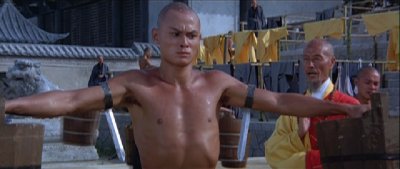 Return to the 36th Chamber of Shaolin
Return to the 36th Chamber of Shaolin also stars Liu, this time as an actor, er con man, dressed up like a Shaolin monk. When the local Han silk workers are bullied and threatened by a bunch of imported Manchu workers, the workers conspire to trick the Manchus into thinking that Liu is actually Shaolin kung fu master San Te. The elaborate ruse works for a while, but after Liu is found out, and soundly thrashed, he goes to Shaolin to try to get into San Te’s 36th Chamber. He manages to con his way in, but is quickly found out. A bemused San Te (played this time by another actor), takes the bumbling Liu in as an apprentice, but that plan quickly falters, and Liu spends three years putting up bamboo scaffolding, where in the great tradition of kung fu training films, learns martial arts from seemingly menial labor (“Wax On, Wax Off!”). When San Te throws Liu out of the monastery, Liu returns to his village dejected, thinking he has learned nothing. After unknowingly displaying his kung fu mastery, Liu proceeds to beat the Machurian kung fu masters, restoring the dignity of the Han Chinese workers, as well as their rightful wages.
Both films are quite different, but enjoyable in their own ways. The 36th Chamber of the Shaolin is more notable for it’s training sequences. While we do not see all of the 35 Chambers, the structure of the screenplay (Liu visits a Chamber, initially fails or experiences difficulties, and then masters the chamber’s lesson) allows Lau Kar-leung to craft amazing vignettes showing displays of almost super human speed, agility, strength, skill, and endurance. The training sequences are so, well cool, that the final kung fu duels between the Han and the Manchurians seems kind of letdown in comparison. Return to the 36th Chamber of Shaolin is much a more of a broad comedy, sometimes too broad, to the point of grating (check out the guy with the huge buck teeth), and the training sequences pale in comparison to the first film (loved the scene with the rock and the well). However, when Liu returns to his village and displays his new found mastery of “scaffolding kung fu,” well the film launches into a transcendent display of inventive acrobatics and balletic kung fu. The finale of Return to the 36th Chamber of Shaolin is 20 minutes of sustained combat, some of the most exciting I’ve seen since I watched Swordsman II. When Liu begins lashing people to bamboo poles, and the bad guys attack him with folding chair, you can see where Jackie Chan got a lot of his ideas (the mixture of kung fu and comedy, the usage of everyday objects, and elaborate set pieces).
The Cinematheque’s wuxia pan series is now over, and I will forever regret missing the first two weeks of the series. It’s right up there when I skipped Fuller’s The Steel Helmet for a girl. What was I thinking?
The Eye (The Pang Brothers)
I absolutely hated the first Pang Brothers film I saw, Bangkok Dangerous, an unholy mixture of John Woo and Wong Kar-wai’s worst qualities. That cinematic abortion was at the back of my mind when I saw the Pang Brothers newest film, The Eye. I must say that I was pleasantly surprised; for one thing, the Pang brothers were relatively restrained, with none of the seizure inducing excess of their earlier film. Despite some moments where the film skirted into mawkish Sixth Senseish territory, The Eye was a fairly effective supernatural thriller about a young blind woman in Hong Kong who begins to see ghosts after her cornea transplant. Most of the plot was fairly predictable (would the newly psychic heroine see the ghost of the young cancer stricken girl who she befriended, but of course; though I have to say, I didn’t see one plot twist coming), but there were some effective jolts, and the film created palpable tension, using basic, but oh so effective formal elements, especially the framing (activating off screen space, always a good thing), precise editing (the sequence in the elevator), sound design, and changes in camera focus (fitting in a film about a blind woman slowly regaining her sight). Often times, we see, from the POV of the heroine, blurry, vaguely threatening shadows. The Eye reinforces a lesson I’ve learned many times by watching the movies: If I go blind, I never want to get my sight back. I mean, does anything good every happen after you miraculously regain your sight?
Something else added to my experience of going to The Eye; I saw the film in an old, 1927 picture palace, which was almost completely deserted (I saw it on a Monday night). Man, afterwards, when I had to go to the basement to use the restroom, well I felt a little uneasy.
My Thoughts on Lost in Translation
 On Sunday, I finally got a chance to see Sofia Coppola’s newest film, the much talked about Lost in Translation, so I’m a little late for the party. I’m finally sidling up to the bar, with a glass of Suntory whiskey in my hand, to discuss some of my thoughts regarding the film with all my compatriots in New York and Los Angeles, who saw it a good two weeks before me. I don’t want to rehash phyrephox’s earlier review, and I certainly agree with many of the his points, as well as those of the others who posted in his review below. So I think I’m just going to kind of free associate about some ideas that have been kicking around in my head since I’ve seen the film.
First of all, I valued the film as a warm observational portrait of a brief, yet fruitful, encounter between two lonely and isolated persons, who are both kind of adrift in their respective lives. I loved how Coppola created a textured mood and environment (the greatest strengths of her earlier film, The Virgin Suicides, probably immeasurably aided by her work as a professional photographer), and then created a narrative that simply allowed the characters to be together and hang out. The narrative is playful and joyous, we the audience take pleasure in the characters proximity to each other, as their chemistry is palpable (I think the saddest moments are when the two characters are apart, Johannson sitting alone in the window gazing at the Tokyo skyline, visiting Kyoto alone, he riding in forlornly in a taxi, or playing golf in the shadows of Mt. Fuji). For me, my favorite sequence of the film was Bob and Charlotte’s first night out in the neon-drenched environments of Tokyo; it’s comfortable and intoxicating, like sharing a good night out on the town with friends. You almost want to get up and join the party, singing karaoke with Murray and Johannson (it’s humorously painful to watch the drunken Bob try to communicate these feelings to his wife).
Lost in Translation is probably the second best examination of developing love in the cinema this year, the first being David Gordon Green’s All the Real Girls; and I don’t mean romantic or sexual love (though I think that Bob is definitely interested in such a relationship with Charlotte, to the effect that he disastrously picks up the jazz chanteuse, much to his, and Charlotte’s regret), which is refreshing. It’s so rare that you see actual friendship blossom between movie characters, much less between a man and a woman, and much, much less between an older man and a much younger girl. But it’s love none the less, from the time that Charlotte first flashes her thousand watt smile at Bob (I never thought much of Johannson in either Ghost World or The Man Who Wasn’t There, but here her ingenue is sexy and intelligent, and her smile out shows anything Julia Roberts has to offer), to their final, secretly whispered words and tender kiss on the crowded streets of Tokyo.
I said it before in the comments under phyre’s post, but the usage of Tokyo is not incidental. It’s one of the ultimate late capitalist cities, where everything seems new (hey, the city’s been destroyed and rebuilt, what 50-60 times, by Godzilla and friends), and where everything seems to be a brightly colored billboard, it’s Times Square on acid, neon disorientation and computerized hallucinations. Coppola captures it all very well with her camera, but I think she picked it for more reasons than simple beauty. I think she picked Tokyo because their is more dislocation and confusion in something that seems superficially similar, than in something completely alien. When faced with something completely alien, people have a tendency to try to find and or create connections and similarities, but when something is similar but not, people tend to become confused, because the differences become magnified when you have something to compare it to. Just think of the scene where Bob watches one of his old movies dubbed into Japanese, it’s the ultimate in strange seeing something so familiar, yet so foreign. Sure, there are other locales that Coppola could have used, like Hong Kong, that would have offered her roughly the same ambiance and that would have afforded her the opportunity for her height jokes, or accent jokes, or her playful sendup of Japanese pop culture, but not many. In any case, the disorientation of the city, of their jet lag, and of their flagging marriages, just serves to drive the two closer together, and it’s here they do make a private space for each other (at one point, Bob says he doesn’t want to go home anymore). It’s Tokyo as Oz, except who wants to return to the drab realities of home. I’d rather sit up all night and watch La Dolce Vita on TV with my friend, or party all night. (And while I’m at it, I’ve read some commentary, comparing the film to the works of Antonioni, principally because of Coppola’s judicious usage of silences, as well as the two alienated characters. That’s just wrong. 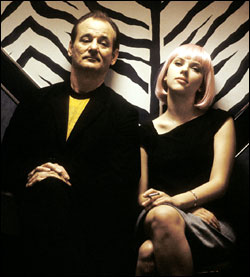 For one, Antonioni’s characters are all completely alienated from each other. If you want to compare Coppola’s film to that of a contemporary director, I would go more in the direction of Wong Kar-wai).
And while I’m at it, let me just pencil in Bill Murray for the Oscar. Not that I think the Academy will give him much consideration (and the new MPAA guidelines should hurt this relatively small film), despite the buzz. It’s still a comedy, and Murray is still seen by many as, well, a comedian, not an Actor (though I still can’t figure out why I still pay lip service to the idea that the Oscars are a barometer of quality). But for my money, Murray is one of the finest American actors working in film today, from his memorable early roles on SNL, Stripes, Tootsie, and Ghostbusters to his newer work in art films like Rushmore, Hamlet, and now Lost in Translation, to which he brings not only his wry sense of humor, but his sad eyes and lumpen features. Murray’s usage of body language is instructive, especially for a film which relies so much on the unspoken. The one shot that is emblematic of their relationship, is when Bob and Charlotte sit on the bench, in the extremely narrow hallway; he sits silently, legs crossed, hands resting on his knee, she, wearing the bright pink wig, rests her head on his shoulder.
demonlover
What if there was no Philip Marlowe? What if you found yourself adrift in a dangerous, corrupt cityscape with no wry private eye to guide you? Olivier Assayas’s demonlover purports just that, thrusting the viewer in the midst of a complicated and half-explained corporate bidding war that is as much about abstract contract negotiations as it is about the sex and violence that intertwines  within the business. The first true contemporary neo-noir, demonlover finally updates the ancient genre with all the modern progress since its inception, restaging the chiaroscuro gritty underbelly of city life in the frigid, soulless bourgeois world of the multinational multimedia industry. The film principally follows Diane (Connie Nielson), a cold executive who ascends to the top of her company through corporate treachery, which may sound like sly deal-signing, but in this business world it equates to drugging her superior Karen (Dominique Reymond) into delirium so she can be robbed of contract documents. To get an idea of how the film layers its bland depiction of the contemporary business world with the up-clos-and-personal brutality of noir, Karen bitterly equates her experience to rape, and it is ambiguous if she is referring to her own personal injury, or that of losing her firm’s documents. Around Diane is her firm’s male counterpart Hervé (Charles Berling) who is more interested in the sexual politics of his position than business practices, and Elise (Chloe Sevigny), Karen’s assistant who holds a dangerous grudge against Diane usurping Elise’s boss. Hervé and Diane are working on securing the distribution rights for a Japanese adult anime and manga company that needs financing to push their outdated, unpopular 2-D adult animation to more realistic and costly 3-D computer productions. While they nail down the terms for the contract with the Japanese, Diane and Hervé are also negotiating with the American company Demonlover.com that owns a majority of the market share for animation and comic books, as well as an extensive catalog of pornographic websites. Demonlover.com’s competitor is paying Diane to spy and sabotage the deal so they can secure the rights to the adult animation, and not be gobbled up by Demonlover.com. Diane’s hands-off espionage turns messy when she is caught breaking into the American’s hotel room and is forced to kill to cover her tracks. Meanwhile, Karen discovers Diane’s role and pursues to ensnare her deeper into the complicated system of corporate backstabbing.
Using complicated but oblique contract discussions as its backdrop, Assayas frames his characters in a world just as sinister, anonymously violent, alienated, and perverse as anything in Chandler, the only difference is that demonlover takes place on the  top floors of sleek corporate office buildings, chic Japanese restaurants, the frontseats of Mercedes SL500s, and most importantly, in front of video cameras, televisions and computer screens. The film is a rich texture of mixed languages and mixed media, and there is a circular line drawn that connects the extortion, sexual games, and backstabbing of Diane’s corporate world with the brutal visual exploitation of hentai, action movies, and finally what demonlover sees as the integration of real life with those mediums-interactive media experiences. One of the contractual issues of the negotiations is the mysterious ownership of a website called Hell Fire Club, where subscribers can send in requests for sadistic torture fantasies and have them enacted, filmed, and posted on the webpage. Assaysas’s commentary is working on a number of levels, the most obvious being the criticism of these businesses that are too self-involved in leveling up in the management or making a quick buck than really paying attention to the kind of material your company actually is exploiting. More interesting is the connectivity between the graphic violence and sexuality of media experiences intertwining with the lives of these business people, and then presenting that layered picture as the film itself, turning a business drama into a sex and violence filled thriller. As with most film’s that strive to say something about the diegesis as well as the medium it is delivered in, demonlover is far too detailed and complex to dissect in one viewing alone.
Connie Neilson, tall, beautiful, athletic, and with her hair cropped short, looks surprisingly stylized like a female anime heroine, and Assayas has fun filling his out his cast with hunks and babes rather than businessmen (Gina Gershon plays a prominent executive of the American 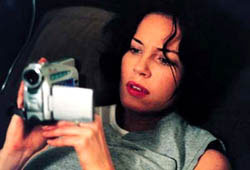 company, and Diane’s boss, played by Jean-Baptiste Malartre looks more like a sadistic Mafioso). As usual Assayas shoots nearly the whole picture handheld, here in an appropriate visual scheme that eschews classic noir expressionism for what feels like a thriller extension of Antonioni’s urban alienation. Combined with a harsh, atmospheric ambient score by Sonic Youth demonlover perfectly achieves a portrait of a inhumane, passionless modern world where sex and money and power end up bringing about more trouble than they’re worth, yet everyone strives as hard as they can to attain them. If demonlover’s central ideas are not particularly coherent, it is only because of the supreme difficulty in completely updating an old genre. This is certainly not a corporate thriller; this is corporate noir and people ruthlessly do all they can to gain power and remain on top, but their lives are heartless and empty and there is no warm-blooded hero to hold your hand through this world. Without Marlowe to make sense of it all, dismiss petty disputes, ignore the loose ends, gather the clues, and set the dame’s head right, we are lost. Diane is a femme fatale without her counterpart, and this world seems too brutal to include someone as helpful and wry as Marlowe, someone who makes sense of what he can, and tries to pull the girl out of her downward spiral into manipulative oblivion. It is a sad statement to say that there is no realistic place in contemporary noir (or this awful world) for the archetypal hero, but then again demonlover presents a self-consuming urban world, one which may be terrible, but there is no need for a detective to clean up the bad element; here the element is so bad it destroys itself.
|

